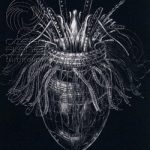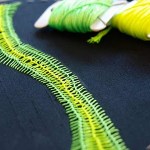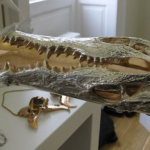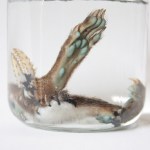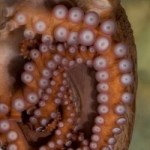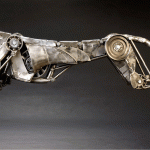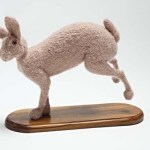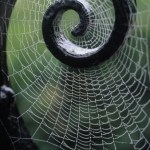biology
tags: evolutionary biology, behavioral ecology, molecular ecology, personality, novelty seeking, exploratory behavior, dopamine receptor, dopamine receptor D4 gene, DRD4 gene polymorphism, ornithology, birds, Great Tit, Parus major, researchblogging.org,peer-reviewed research, peer-reviewed paper
Bold or cautious? Individuals with a particular gene variant are very curious --
but only in some populations.
Image: Henk Dikkers.
Research suggests that personality variations are heritable in humans and other animal species, and there are many hypotheses as to why differences in personality…
Three cool pieces of science have been retrieved from the depths.
In the L'Atalante basin, one of the Mediterranean sea's deep hypersaline anoxic basins, anoxic metazoans have been discovered. That means multicellular beings like you, Dear Reader, who live without oxygen. They're loriciferans, Sw. korsettdjur, each less than a millimetre long. Instead of breathing like you, aided by endosymbiotic mitochondria, these beasties have another kind of power plant inside their cells similar to hydrogenosomes, that is, they're chemotrophic.
In a bog on the high wooded hills of temperate Hanveden…
This is pretty neat: scientists have apparently discovered the first example of truly anaerobic animal life (i.e. an animal that can survive in the absence of oxygen). This isn't some sort of fuzzy critter, though; instead, these are tiny (less than 1 mm in length) animals that were found on the floor of the Mediterranean Sea. The animals belong to the phylum Loricifera (see illustration below). Significantly, these animals lack mitochondria, the sub-cellular organelles where oxygen is employed to produce ATP in aerobic (oxygen-dependent) life.
You can check out the original paper by Danovaro…
The new blog Kingdom of the Blind documents an ongoing collaboration between embroiderer/artist Melody Lord and neuroscientist Adam Hamlin. The title is from Jim Endersby's book A Guinea Pig's History of Biology: "Science is the kingdom of the blind: there are no sighted - or even one-eyed - people, because we have no way of looking directly at reality to assess what it is like."
On the blog, Adam Hamlin occasionally posts about his work with the cholinergic cells impacted by Alzheimer's disease, while Melody shares her inspirations from the lab, and the challenges of finding the right…
Here's a pretty little visualization by Hybrid Medical Animation: a demo reel of clips portraying various physiological processes and medical devices in action, in various styles of animation:
hybrid 2010 reel from hybrid medical animation on Vimeo.
One of my frustrations with medical animations is that they're a Disneyfied look at the body. Real biology is dirty, sticky, unpredictable, and a little dangerous - kind of like Times Square used to be. But in medical animations the body is always a minimalist, sterile Kubrickian utopia, usually in Pottery Barn colors, where pretty little…
Style Bubble has some snapshots of luxe skull- and carapace-inspired jewelry by Dominic Jones. You've just got to love a crocodile skull vambrace!
See more snaps at Style Bubble.
Via Haute Macabre - you musn't miss their other recent post on Dominic Jones' work for Vice Magazine. Here's a teaser:
Myrmicocrypta camargoi Sosa-Calvo & Schultz 2010
Brazil
The world's ant fauna continues to yield new treasures. Myrmicocrypta camargoi, described in a new paper by Jeffrey Sosa-Calvo & Ted Schultz, is the largest species in this fungus-growing genus.
source: Sosa-Calvo, J., Schultz, T.R. 2010. Three Remarkable New Fungus-Growing Ant Species of the Genus Myrmicocrypta (Hymenoptera: Formicidae), with a Reassessment of the Characters That Define the Genus and Its Position within the Attini. Annals of the Entomological Society of America 103(2):181-195.
doi: 10.1603/AN09108
artwork by…
Nate Hill has a strong stomach and, er, unique artistic vision: he likes to cobble sculptures together out of dead animal parts. While his "New Animals" are the sort of clever, genteel, well-sealed artifacts you might find in a trendy loft belonging to a medical illustration enthusiast, his "ADAM Project" is rawer: it's a life-size human figure made of meat. Lots of fishheads. With chicken head genitalia.
No, not genteel at all. Looks like some of the gallery visitors felt a bit faint. No wonder he calls his website "Nate Hill is Nuts".
Thanks to Tom for this one.
Last month, in response to some truly despicable activities by animal rights zealots, I wrote a series of posts about how animal rights activists target even researchers' children and appear to fetishize violence. This simply continued a string of posts that I've done over the years, the longest (and, in my not-so-humble-opinion, the best) deconstructs a lot of the bad scientific arguments used by animal rights activists to claim that animal research is useless, or nearly so, as well as other arguments made by extremists. One of the key points emphasized in these responses is that, regardless…
tags: evolution, evolutionary biology, UV light, flight, dinosaur, dromaeosaur, theropods, Microraptor gui, paleontology, fossils, birds, researchblogging.org,peer-reviewed research, peer-reviewed paper, journal club
Figure 1. The holotype of Microraptor gui, IVPP V 13352 under normal light. This shows the preserved feathers (white arrow) and the 'halo' around the specimen where they appear to be absent (black arrows). Scale bar at 5 cm. [larger view]
DOI: 10.1371/journal.pone.0009223
It has long been known that when exposed to ultraviolent light, fossilized bones and shells -- and even…
Good idea: the National Zoo is letting us name its Giant Pacific octopus.
Bad idea: the names. All four are terrible:
Olympus: This octopus arrived at the Zoo just before the 2010 Winter Olympics, and for many zoogoers the octopus gets a gold medal for being a compelling animal.
Ceph: Octopuses belong to the fascinating group of animals called cephalopods (class Cephalopoda), which means "head-foot." The arms or feet (podos in Greek) of these animals are on the front of their head ("cephalo" comes from the Greek kephale, for head).
Octavius: "Octavius the Octopus" is more than just a pretty…
tags: evolution, evolutionary biology, behavioral ecology, animal behavior, molecular ecology, parental care, mating systems, monogamy, sexual selection, frogs, poison dart frogs, Dendrobatidae, Ranitomeya, researchblogging.org,peer-reviewed research, peer-reviewed paper, journal club
Peruvian mimic poison frog, Ranitomeya imitator.
Image: Jason Brown [larger view]
To know the breeding system is to know the genetic architecture of a species.
To know the evolution of a breeding system is to know how evolution works ..
~ Lewis & Crowe, Evolution (1955)
Genetic tests have revealed the…
I don't think I've posted yet about Andrew Chase's graceful articulated metal sculptures. His cheetah is particularly stunning.
Click the image to watch it run!
Chase's mechanical sculptures have way more personality than metal should. The soulful eyes of his elephants and giraffes could reflect some futuristic world in which extinct flesh-and-blood animals have been (inadequately) replaced with patchwork gestures at nature. Or perhaps they look lonely because they're intimidated by the flesh-and-blood inspirations of which they are ingenious, but dead, replicas.
Robot Timmy Recharging…
I'm an epidemiologist, not an immunologist or a virologist but I like reading immunology and virology. It's interesting, in some ways for me it's more interesting than reading epidemiology. In an epidemiological paper I can see pretty quickly where things are going (or going wrong) and there isn't much mystery. But the sheer number of moving parts in a cellular system is amazing and confounding. Navigating through the myriad bits and pieces that appear every week in the scientific literature is tough for experts and even tougher for the rest of us who aren't experts. Vincent Racaniello over…
Doesn't that title sound weird - like an experimental film? It may help to know that House of Sweden is Sweden's embassy in Washington, DC - a lovely glass building on the Potomac. If you're in the DC area, you should get on their mailing list, because they host interesting science-related panel discussions and receptions. Yesterday, they opened a new exhibit - the Virtual Autopsy Table. It's a touch-screen tabletop that lets you slice into, rotate, and magnify an MRI-based 3D representation of the human body, all with a brush of a hand:
The Virtual Autopsy Table from Norrkö…
On Friday the blackbirds opened their concert season. Here's what I wrote about them four years ago.
Oh, still my heart -- I just heard the year's first blackbird serenade! I opened the kitchen window a crack and listened to it while having my evening sandwich and cup of rooibos. I love the blackbird. It sings at the most unsettling time of the year.
These spring and early summer evenings, when the light never really fades and the blackbird sings its heart out... They fill me with a nameless urgency, a desperate itch for something I can't put words to. Watching myself dispassionately from…
Shauna Richardson crochets life-sized taxidermied animals - "crochetdermy". Because she can and because no one else thought of it first. Read more at Dazed Digital.
Spring is coming slowly, but it's finally coming. These squills have been awakened by heat radiating from our house, but still they reach for the sun.
In other news, Discover Magazine continues to buy over top Sb bloggers, and I have finally learned the story behind the state of Oklahoma's weird panhandled outline. Briefly put, it ended up that way because the state of Texas allowed slavery but the Union allowed it only south of a certain line. And so when Texas joined the Union, it ceded a ribbon of land that was north of the slavery line.
This beautiful photo by Kindra Clineff catches nature one-upping human craftsmanship. I can just hear that spider piping "neener neener neener". Also, it's a perfect follow-up to Christobal Vila's graceful animation about math in nature, which has now officially gone spiral-viral.
Buy a print here.
Via NOTCOT.
We continue to learn a great deal about influenza infection as researchers harvest information from the recent swine flu pandemic. The pork producers don't like to call it "swine flu" but it may well be that its long sojourn in that animal since 1918 (did we give Spanish flu to pigs or did pigs give it us?) may hold an important clue to why older people suffered less than younger ones. It seemed fairly likely that the difference was related to immunity, but since H1N1 came back in 1977 after being absent since 1957, it wasn't clear why younger people born after 1977 would be as immune as…
